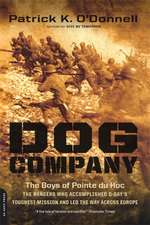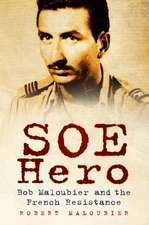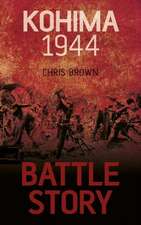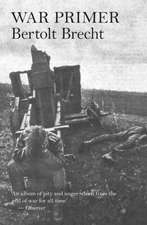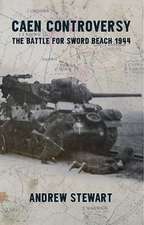Soviet Documents on the Use of War Experience: Volume Three: Military Operations 1941 and 1942: Soviet (Russian) Study of War
Editat de Harold S. Orensteinen Limba Engleză Hardback – mar 1993
| Toate formatele și edițiile | Preț | Express |
|---|---|---|
| Paperback (2) | 284.52 lei 6-8 săpt. | |
| Taylor & Francis – 24 apr 2016 | 284.52 lei 6-8 săpt. | |
| Taylor & Francis – 9 iun 2015 | 459.71 lei 6-8 săpt. | |
| Hardback (2) | 701.56 lei 6-8 săpt. | |
| Taylor & Francis – mar 1993 | 701.56 lei 6-8 săpt. | |
| Taylor & Francis – noi 1991 | 1102.88 lei 6-8 săpt. |
Din seria Soviet (Russian) Study of War
- 15%
 Preț: 448.46 lei
Preț: 448.46 lei -
 Preț: 424.71 lei
Preț: 424.71 lei - 14%
 Preț: 299.36 lei
Preț: 299.36 lei - 15%
 Preț: 463.34 lei
Preț: 463.34 lei -
 Preț: 490.25 lei
Preț: 490.25 lei -
 Preț: 489.26 lei
Preț: 489.26 lei -
 Preț: 478.98 lei
Preț: 478.98 lei -
 Preț: 486.21 lei
Preț: 486.21 lei -
 Preț: 432.04 lei
Preț: 432.04 lei -
 Preț: 488.29 lei
Preț: 488.29 lei -
 Preț: 444.62 lei
Preț: 444.62 lei -
 Preț: 484.85 lei
Preț: 484.85 lei -
 Preț: 413.76 lei
Preț: 413.76 lei -
 Preț: 492.20 lei
Preț: 492.20 lei -
 Preț: 284.52 lei
Preț: 284.52 lei -
 Preț: 416.22 lei
Preț: 416.22 lei -
 Preț: 483.49 lei
Preț: 483.49 lei -
 Preț: 409.51 lei
Preț: 409.51 lei
Preț: 701.56 lei
Preț vechi: 855.56 lei
-18% Nou
Puncte Express: 1052
Preț estimativ în valută:
134.24€ • 140.17$ • 110.85£
134.24€ • 140.17$ • 110.85£
Carte tipărită la comandă
Livrare economică 15-29 aprilie
Preluare comenzi: 021 569.72.76
Specificații
ISBN-13: 9780714634029
ISBN-10: 0714634026
Pagini: 238
Dimensiuni: 152 x 229 x 24 mm
Greutate: 0.48 kg
Ediția:1
Editura: Taylor & Francis
Colecția Routledge
Seria Soviet (Russian) Study of War
Locul publicării:Oxford, United Kingdom
ISBN-10: 0714634026
Pagini: 238
Dimensiuni: 152 x 229 x 24 mm
Greutate: 0.48 kg
Ediția:1
Editura: Taylor & Francis
Colecția Routledge
Seria Soviet (Russian) Study of War
Locul publicării:Oxford, United Kingdom
Cuprins
Operational results of the rout of the Germans at Moscow: the defensive engagement on the Western front; the counteroffensive of the Red Army on the Western front and the rout of German-Fascist forces; the further development of the Western front offensive from the line of the Lama, Ruza, Nara and Oka rivers. Actions of General Belov's group in the Germans' operational rear: penetration of the German defence and raid on Viaz'ma; the offensive against Viaz'ma; the offensive against Semlevo; the offensive against Iakovlevo; group offensive in the area of Isdeshkovo; the offensive to liberate 329th Rifle Division and 250th Air-Assault Regiment from encirclement; the offensive in the area of the Ugra siding. Operations of 4th Air-Assault Corps in the enemy's operational rear; general situation; the 4th Air Assault Corps offensive against Pesochnia; defensive battles in March 1942; German penetration in the direction of Verterkhovo station, Ugra siding; the offensive against Marino; battles in encirclement and breakout from encirclement. Some conclusions with respect to left-flank operations of the Western front; the offensive of 61st and 16th Armies in July 1942; operations of 16th and 61st Armies, and 3rd Tank Army in August 1942. Maskirovka support of an offensive operation: mission of the operation and Maskirovka decision; execution of Maskirovka measure; plan of Maskirovka measures in the zone of actions of the Northwestern front (for the period 10-22 July 1942). The experience of organizing the rear of the Crimean front (January-May, 1942): brief characterization of the Crimean Peninsula; general conditions by the beginning of the assault operation; planning and preparation of the assault operation; the operation of the rear during the fight for the Kerch' Peninsula; establishment of a rear area in Crimean front offensive operations. Combined actions of river flotillas and ground forces: principles of the combat use of river flotillas; combat actions of the Danube military flotilla; actions of the Volga flotillas in the area of Stalingrad. Study of combat experience in the Karelian front. Use of a tank destroyer artillery regiment. Instructions on the combat use of Red Army air-assault forces (plan): general position; organization and execution of an air-assault operation; control of an air assault during its actions in the enemy's rear area; the link-up of an air assault with its forces. Orders, directives, instructions: to all chiefs of Front chemical directorates; changes in articles of the plan for field regulations related to the combat use of cavalry.
Descriere
The Soviet Study of War" series examines the lessons Soviet military theorists and commanders learned from the study of their own military experience.
Notă biografică
Introduction by David M. Glantz; Translated by Harold S. Orenstien



